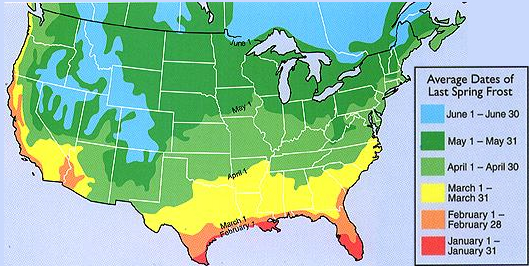
Spring frost free dates

The runner-up question,
after "When
should I plant my first spring vegetables?"
is always "What is my frost free date?" I have to admit that
frost free dates are unimaginably vague, and if you ask three different
people, you'll probably get three different answers. For goodness
sake, I asked two different extension agents (supposedly your best bet
for local information) and got two different answers.
Officially, you can use
the frost-free map reproduced above (which seems to think we're frost
free somewhere between April 1 and April 30) or city
tables like this one
(if you happen to have a city in your vicinity, which we don't.)
No matter where you find your local frost-free date,
you should be aware that microclimate effects mean everything in the
changeable spring. If you live on a north-facing slope, you may
really be one zone colder than if you lived on the south-facing slope
across the valley. If you live near a large body of water or in
an asphalt-laden city, you
may be one zone warmer than if you lived just a few miles away.
Higher elevations, of course, will also be colder than lower elevations
(although many mountains have frost lines with apple orchards safely
protected at the higher elevations from late spring frosts.)
The best way to know
your frost-free date for sure, of course, is to start keeping a weather
journal. Last year, we had a frost
on May 18, so I'm
sticking with my May 15 prediction and ignoring folks who think we're
frost free any earlier.
Want more in-depth information? Browse through our books.
Or explore more posts by date or by subject.
About us: Anna Hess and Mark Hamilton spent over a decade living self-sufficiently in the mountains of Virginia before moving north to start over from scratch in the foothills of Ohio. They've experimented with permaculture, no-till gardening, trailersteading, home-based microbusinesses and much more, writing about their adventures in both blogs and books.
Want to be notified when new comments are posted on this page? Click on the RSS button after you add a comment to subscribe to the comment feed, or simply check the box beside "email replies to me" while writing your comment.

Anna, this is a note to your comment that I just read. I notice a lot of gardeners take the middle of the summer off in Louisiana as well. Then we get a SECOND spring-type planting opportunity between Aug-Dec. I grew tomatoes last year and had fresh cherry tomatoes up until the end of November when our first frost hit. We put our fall/winter veggies in the ground in September and we still have remnants of those left while we start our spring gardens in hopes that the weather doesn't get too hot before things are ready to harvest.
The native plant society takes the summer off here, but then the gardening groups will work steadily all through the winter. It's quite different from Virginia, for sure.
Sara --- does that mean you're past your frost free date, or just that you're planting your more cold hardy spring garden? It sounds like the pecan buds are serving you well!
Your gardening year sounds complicated! Of course, ours probably would too, if I wasn't so used to it. But getting two springs per year is odd...